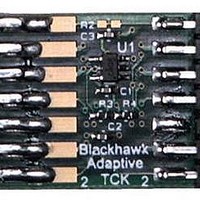BH-EMU-JACK Blackhawk, BH-EMU-JACK Datasheet

BH-EMU-JACK
Manufacturer Part Number
BH-EMU-JACK
Description
Programming Accessories OMAP JTAG Adapter
Manufacturer
Blackhawk
Datasheet
1.BH-EMU-JACK.pdf
(2 pages)
Specifications of BH-EMU-JACK
Product
Calibration Tool
Lead Free Status / RoHS Status
Lead free / RoHS Compliant
4
Probing TCK and RTCK
The output (TCK) and return (RTCK) test
clocks are easily accessible via the target
board’s JTAG header on pin 11 (TCK) and
pin 9 (RTCK). Attaching oscilloscope probes
to these pins will give you the ability to view
the clock synchronization with and without the
adapter in place.
Figure 6 below shows the output of the test
clock signals using an emulator that does not
handle the adaptive clocking feature of the TI
OMAP cores.
For this example, measurements were made
with the emulator connected to an OSK5912
as the target board. You can see that the
clocks are not synchronized, which can lead
to data corruption and reduced performance.
Figure 7 shows the output from the same
clock signals, using the same emulator con-
nected to the same OSK5912 target board.
The only difference is that we inserted the
JACK between the target board’s JTAG
header and the JTAG connector of the emula-
tor.
This shows that, without changing the emula-
tor, target board, or any settings, the clock
edges are fully synchronized. The TCK sig-
nal is adapting to the changes in RTCK from
the OMAP device’s core clock.
Solving the TRST Issue with the TI XDS510
XDS510-class emulators that depend on the TI SN74ACT8990 test bus controller (TBC) to assert
the TRST signal are susceptible to a dead-lock condition with certain OMAP cores that stop
RTCK when TRST is asserted. Because these cores stop RTCK, the TBC enters a suspended
state, never updates, and will not clear the asserted TRST signal.
To solve this issue, the adapter board will route TCK to RTCK if it detects RTCK has stopped
when TRST is asserted (see Figure 3). You will find that the TI XDS510 ISA card and other TBC-
based emulators will now work with all OMAP devices when this adapter kit is being used.
XDS560-class emulators, which do not rely on the TBC for asserting TRST, will not be affected by
the JACK’s TRST logic.
Signal Analysis
Blackhawk
123 Gaither Drive
Mt. Laurel, NJ 08054-1701
www.blackhawk-dsp.com
+1-877-983-4514
Blackhawk is a registered trademark of EWA Technologies, Inc.
BH-Jack-QS-01
Figure 6—Non-adaptive clocking Emulator
Figure 7—Adaptive Clocking Emulator
Overview
The JTAG Adaptive Clocking Kit (JACK), shown in
figure 1, is designed to allow JTAG emulators for TI
DSPs to synchronize with the adaptive clocking cores
of Texas Instruments OMAP™ devices providing com-
plete data integrity and increased performance.
What is Adaptive Clocking?
Adaptive clocking is a feature of synthesizable cores,
introduced by ARM
OMAP platform, wherein the input test clock (TCK) is delayed and synchronized with the core clock
before producing the output clock (RTCK). Emulators need to adapt to this changing RTCK signal.
During this delay (synchronizing period) the target core samples Test Data In (TDI), Test Mode
Select (TMS), and TCK with the core clock. This delay is variable and changes in real time, which
can cause data corruption.
Figure 2 shows an example of this
synchronizing mechanism inside the
OMAP processor core. Here you can
see the multi-stage synchronizer
consisting of several D-triggers,
which is dependant on the core clock
rate.
Figure 3 illustrates the JACK logic to
handle these real time changes to
RTCK. The resulting logic will main-
tains synchronization with the JTAG
signals as the rate of the OMAP core
clock changes.
You may find emulator release notes
that
(workarounds) that are necessary to
operate with these TI OMAP adaptive
clocking cores. This usually involves
decreasing the output TCK rate of the
emulator.
correct the problem, the data and
clock signals will still not be synchro-
nized with the OMAP core clock and
you will only decrease performance.
Compatibility
This JACK is designed to be compatible with the traditional 14-pin emulators supporting the com-
mon JTAG functions and signals. This includes XDS510™-class and XDS560™-class emulators.
The JACK will also work when connected to non-adaptive clocking targets.
QUICK
START
GUIDE
describe
While this may seem to
setup
®
Ltd. and adopted by TI in their
changes
Blackhawk™ JTAG
Adaptive Clocking
Kit for OMAP™
Figure 2—OMAP Adaptive Clocking Mechanism
Figure 3—JACK Adaptive Clocking Logic
Figure 1 - JACK hardware
Part No. BH-EMU-JACK
1
Related parts for BH-EMU-JACK
BH-EMU-JACK Summary of contents
Page 1
... This JACK is designed to be compatible with the traditional 14-pin emulators supporting the com- mon JTAG functions and signals. This includes XDS510™-class and XDS560™-class emulators. The JACK will also work when connected to non-adaptive clocking targets. Figure 1 - JACK hardware Part No. BH-EMU-JACK 1 ...
Page 2
... GND • 9 RTCK 10 GND Blackhawk is not responsible for any damage that may occur to the JACK, target board, or emulator if misused, mishandled, or forced into place. 11 TCK 12 GND • The JACK is not intended to be hot pluggable, damage may occur. Make sure you emulator and target board are not powered when making connections ...
















